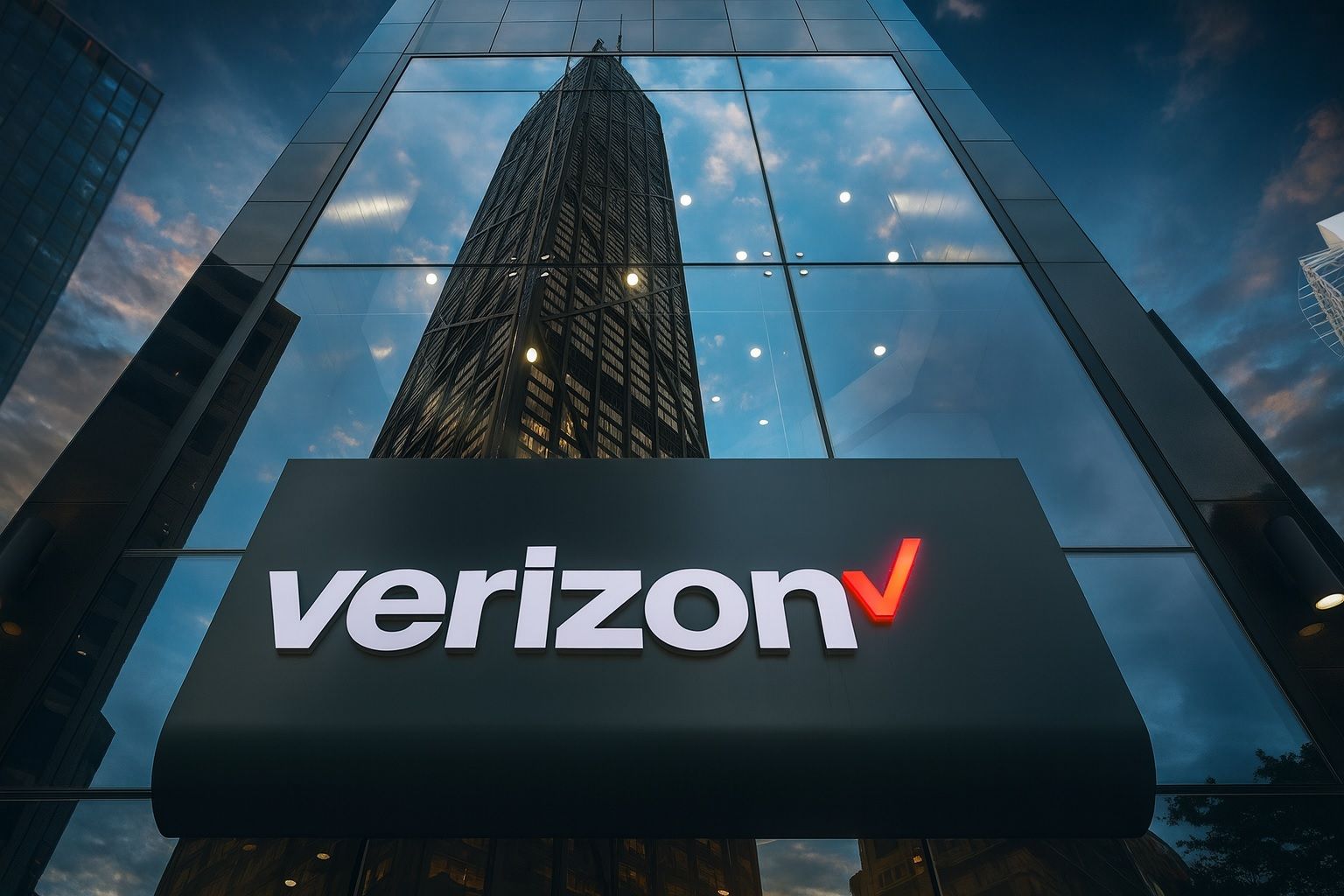- Analyst downgrade: BNP Paribas Exane cut Verizon (NYSE: VZ) from “Outperform” to “Neutral” on Oct. 21, lowering its price target to $44 (≈8% upside) [1] [2]. Analyst Sam McHugh warned the recent CEO change “raises questions about [Verizon’s] strategy and how aggressively they will be willing to defend [market] share” [3].
- Share price reaction: VZ shares fell around 1–3% on the news. Midday Oct. 21 the stock traded as low as ~$40.13 and was last near $40.30 [4] [5]. After trading near $43.70 on Oct 3 [6], the shares are now about 9% below their 52-week high (~$47.35 [7]) and hover near multi-week lows. The stock currently yields ~6.8% on the $0.69 quarterly dividend [8] [9].
- Solid fundamentals: Verizon’s recent earnings and cash flow remain strong. Q2 2025 revenue was $34.5 B (+5.2% YoY) with net income $5.1 B (GAAP EPS $1.18, adjusted EPS $1.22) [10] [11], beating estimates (consensus EPS ~$1.19). The company has raised free-cash-flow guidance to ~$19.5–20.5 B [12] [13] and lifted its dividend for the 19th straight year to $0.69 (yield ~6% [14]). Verizon’s forward P/E is only ~10× [15] (well below the ~17× telecom avg), and credit ratings remain solid (Fitch A–) despite heavy spectrum and debt load [16].
- Leadership & outlook: On Oct. 6 Verizon surprised markets by appointing former PayPal CEO Dan Schulman as its new chief executive [17] [18]. Schulman vowed to “drive financial results that exceed current market expectations” [19]. He inherits a challenging telecom market – slowing wireless growth, tough competition from AT&T, T‑Mobile and cable carriers, and high network spending [20] [21]. Wall Street is split: some (e.g. RBC, JPMorgan, Goldman Sachs) have price targets in the $46–52 range [22] [23], implying ~15–30% upside if growth catalysts materialize [24]; others remain cautious in the near term.
- Industry context: Verizon’s rivals are aggressively expanding. AT&T is bundling fiber and 5G plans and buying fiber assets, while T‑Mobile is deploying satellite-backed coverage and even named a new CEO (Srini Gopalan). Cable operators (Comcast, Charter) continue to steal postpaid subscribers via wireless resale on VZ’s network [25]. These pressures – along with recent widespread network outages – underscore challenges ahead [26] [27].
Analyst Downgrade and Stock Reaction
Verizon’s stock sold off on Oct. 21 after BNP Paribas Exane analyst Sam McHugh downgraded the shares to Neutral and cut his target to $44 [28]. “The recent CEO change at Verizon has raised questions about strategy and how aggressively [the company] will be willing to defend share,” he wrote [29]. This follows broader investor caution after Dan Schulman replaced long-time CEO Hans Vestberg on Oct. 6. (Reuters noted that Verizon was already “battling rising competition” amid slowing subscriber growth [30], causing the stock to tumble about 3% on the day of Schulman’s appointment [31].)
On Oct. 21, Verizon shares fell roughly 1.3% intraday, trading in the low-$40s [32]. At one point the stock dipped to about $40.13 before closing around $40.30 [33] [34]. That left VZ roughly 9% below its recent 52-week high (~$47.4) [35] [36]. (By Oct. 22 it was still trading around ~$40 [37].) Volume was elevated – a sign institutional attention – even as VZ maintains one of Wall Street’s most attractive yields (about 6.8% on the new $0.69 quarterly payout [38] [39]).
Meanwhile, several other analysts have been adjusting their views. Scotiabank recently hiked its target to $50.50 (sector perform), and Goldman Sachs initiated coverage with a Buy at $49 [40]. TD Cowen’s Gregory Williams took the opposite tack, raising his price target to $56 — seeing Schulman’s arrival as a long-term positive [41]. Overall, however, Street sentiment is cautious: no analysts currently have a Sell rating on VZ. TipRanks aggregates a Moderate Buy consensus (roughly eight Buys vs. ten Holds) with an average target around $48 [42] [43].
Strong Fundamentals, But High Debt
Investors note that Verizon’s underlying business remains healthy. In Q2 the company beat estimates with EPS of $1.22 (vs. $1.19 expected) on $34.5 B revenue [44], up over 5% year-over-year. Free cash flow is robust, prompting management to raise guidance to about $19.5–20.5 B for 2025 [45] [46]. Verizon’s network investments have boosted capacity: it added 278,000 fixed wireless broadband customers and 65,000 net wireless postpaid additions last quarter [47], driven in part by deals like its planned $20B acquisition of Frontier Communications (2.2M fiber subs) and the recent purchase of ISP Starry [48] [49].
These positives keep the balance sheet in investment-grade territory. Verizon just notched its 19th straight dividend increase (raising the payout 1.8% to $0.69 [50]). Its forward P/E is only ~10× [51] – a deep discount to the ~17× industry average – partly reflecting higher depreciation and CapEx from 5G rollout [52]. Moody’s/Fitch still rate it A–/F1 (low default risk), signalling confidence that long-term cash flows can service the now-$100+B debt pile [53]. Simply Wall Street’s fair-value model, for example, pegs VZ near $135 (implying ~70% upside) [54], underscoring how far some analysts believe the stock is from its fundamental value.
Leadership Change and Strategy
The big question is whether new CEO Dan Schulman can re-energize growth. A former PayPal chief, Schulman (now 67) told employees his focus is on culture and customer experience. “We must drive financial results that exceed current market expectations,” he declared in his initial memo [55]. The board clearly hopes his success in digital payments will translate to telecom.
As he takes charge, Schulman inherited a mixed strategic picture. Vestberg leaves behind massive investments in 5G spectrum and the Frontier deal, as well as emerging initiatives like integrating satellites and AI into the network. Verizon argues it’s well-positioned: EVP Joe Russo highlights that the Starry acquisition will “accelerate our fixed wireless access capabilities, giving millions of new customers a powerful and affordable broadband option” [56]. Reuters noted Schulman will need to guide Verizon “through slowing wireless growth and increasing competition while continuing heavy 5G and fiber investments” [57]. Indeed, industry watchers expect him to focus Verizon on broadband and enterprise services, even as rivals bundle wireless with fiber and cable companies encroach via MVNO deals [58] [59].
Market Outlook and Forecast
For now, analysts see a mixed outlook. Verizon’s improved cash flow and high yield make it attractive to income funds, but near-term subscriber growth is under pressure. MarketBeat notes that on “financial metrics [Verizon is] quite cheap” [60], but firms like Wells Fargo argue the “short-term setup… remains challenging” due to competition and integration costs [61]. Most forecasts are modest: sell-side models expect roughly $4.69 in full-year 2025 EPS [62] (flat to slightly down), implying limited growth in the next 12 months.
Technically, VZ is trading near recent lows in the low-$40s. TS2.Tech analysis points out that momentum indicators are oversold, suggesting a possible bounce if earnings beat or stabilizing growth come through [63]. Notably, analysts’ consensus targets ($46–52) imply about 15–30% upside from today’s levels if those catalysts play out [64]. However, any sign of another postpaid subscriber decline (as happened in Q1) or higher network costs could push the stock lower.
The next big catalyst will be Q3 results (due Oct. 29). Investors will watch whether Schulman’s early changes translate into improved service and whether Frontier/Starry synergies begin to show. Verizon’s healthy dividend should support the stock if fundamentals hold, but the current leadership overhaul and tough competition mean the road ahead is uncertain. As one analyst succinctly put it, the recent shake-up in Verizon’s leadership has left Wall Street questioning “how [Verizon] will be willing to defend [its market] share” [65].
Sources: Analyst reports and market commentary from TipRanks [66] [67] [68], MarketBeat [69] [70], Reuters [71] [72], and TS2.Tech analysis [73] [74] [75], among others. All data as of Oct 22, 2025.
References
1. www.tipranks.com, 2. www.marketbeat.com, 3. www.tipranks.com, 4. www.marketbeat.com, 5. www.reuters.com, 6. ts2.tech, 7. www.marketbeat.com, 8. ts2.tech, 9. www.marketbeat.com, 10. ts2.tech, 11. www.marketbeat.com, 12. ts2.tech, 13. ts2.tech, 14. ts2.tech, 15. ts2.tech, 16. ts2.tech, 17. www.reuters.com, 18. ts2.tech, 19. www.reuters.com, 20. www.reuters.com, 21. ts2.tech, 22. ts2.tech, 23. ts2.tech, 24. ts2.tech, 25. ts2.tech, 26. www.reuters.com, 27. economictimes.indiatimes.com, 28. www.tipranks.com, 29. www.tipranks.com, 30. www.reuters.com, 31. www.reuters.com, 32. www.marketbeat.com, 33. www.marketbeat.com, 34. www.reuters.com, 35. ts2.tech, 36. www.marketbeat.com, 37. www.reuters.com, 38. ts2.tech, 39. www.marketbeat.com, 40. www.marketbeat.com, 41. www.tipranks.com, 42. www.tipranks.com, 43. ts2.tech, 44. www.marketbeat.com, 45. ts2.tech, 46. ts2.tech, 47. ts2.tech, 48. ts2.tech, 49. ts2.tech, 50. ts2.tech, 51. ts2.tech, 52. ts2.tech, 53. ts2.tech, 54. ts2.tech, 55. www.reuters.com, 56. ts2.tech, 57. ts2.tech, 58. ts2.tech, 59. ts2.tech, 60. www.marketbeat.com, 61. www.tipranks.com, 62. www.marketbeat.com, 63. ts2.tech, 64. ts2.tech, 65. www.tipranks.com, 66. www.tipranks.com, 67. www.tipranks.com, 68. www.marketbeat.com, 69. www.marketbeat.com, 70. www.marketbeat.com, 71. www.reuters.com, 72. www.reuters.com, 73. ts2.tech, 74. ts2.tech, 75. ts2.tech








